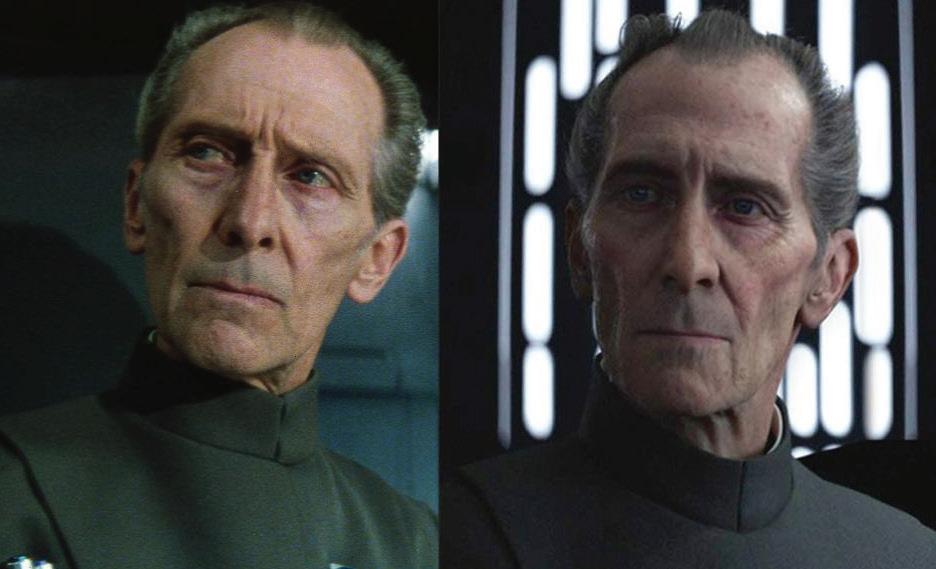
3 minute read
The Ethics of CGI Resurrection
from Fall 2019 Issue 3
by The Slate
BY Brendan Smoller

Peter Cushing as Grand Moff Tarkin in Star Wars: IV A New Hope, and a CGI version of Cushing as Tarkin in Rogue One: A Star Wars Story.
Lucasfilm
Advertisement
James Dean’s casting in an upcoming movie raises questions over the ethics and legality of digitally resurrecting dead actors.
It could be argued that performers are limited in the medium of film. Their performances are trapped within the restrictive four wall frame of a camera lens and an editor decides how much of their performance is seen in the final cut of the film. However, they are generally free to interpret their character, create their own mannerisms, and perform their lines as they see fit.
However, It seems Hollywood is determined to strip performers of this last freedom; Strip it from their graves. James Dean has been dead for over 6 decades. Yet his career is suddenly and moving forward. Directors Anton Ernst and Tati Golykh, when filling roles for their upcoming adaption of the Vietnam war novel, ‘Finding Jack’, apparently decided Dean was the best actor for the part. Thanks to CGI advances, the animation studio Image Engine will endeavour to recreate Dean by using archival footage to generate a new performance. Dean won’t be the film’s lead, but will be in the main cast.
CGI resurrection is not new. Previously, it has been achieved by digitally inserting living actors into archival material. This enabled Tom Hanks to appear alongside long passed presidents in Forrest Gump. However, now studios can digitally insert the face of a dead performer onto a body double. i e. Peter Cushing in Rogue One: A Star Wars Story. According to the general manager of Image Engine, Shawn Walsh, “capturing someone’s essence is down to far more than just their appearance; artists must study archive footage of their subject, looking at how they move, how they hold themselves, how they emote.” “If successful,” says Walsh, “the end result is that the viewer won’t know there is any visual effects involved at all.” However, the public’s reaction to Cushing in Rogue One was divisive. Some questioned if Lucasfilm was ethical in reanimating a deceased actor since you can’t gain their consent. They may have had no interest in the project they are posthumously appearing in.
Legally acquiring the rights to a dead actor’s image is done through their estate or trust. CMG Worldwide, an agency that represents dead celebrities are responsible for selling Dean’s image rights for Finding Jack. Their CEO, Mark Roesler has been quoted saying, “This opens up a whole new opportunity for many of our clients who are no longer with us.”
As the possibility of these resurrections become more prominent, actors must consider if they would be okay with this, after their own deaths. Robin Williams wrote in his will that he does not consent to the use of his voice and image in any future projects for at least the next 25 years. Will his wishes be respected after this date? Only time will tell.
The right to exhume an actor’s likeness, legally, is a conversation of ownership. This new technology turns can an actor’s image into a public property with which anyone can use creatively. Legally however, it still belongs to them. Celebrities’ right to privacy is often overstepped.This tech can turn actors into puppets, manipulated for mass entertainment. But can computers ever truly bring an actor back? Though their faces are stolen from the past and stuck onto new roles, their talent and choices can not be recreated in a computer. All we can possibly have is a digitally enhanced impressionist trapped in an inevitable uncanny valley.
There are countless talented breathing actors. So is there any value to costly digital resurrection other than nostalgia?
An actor’s choices have always been a fundamental aspect of film as an artform. Without it, the soul in the screen irrevocably changes. It vanishes.
A performance by a CGI actor can be intriguing and possibly even impressive. But it could never substitute the real thing. We can not let it.









